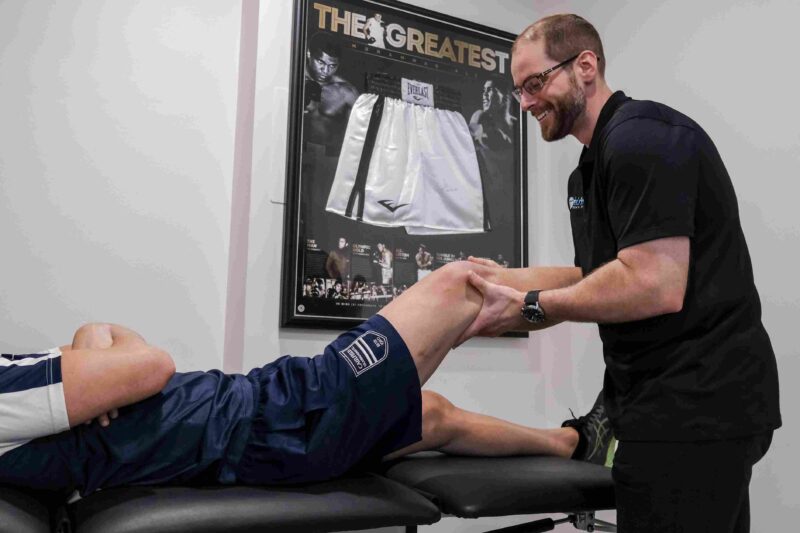
5 Common Sporting Injuries of the Lower Body and How to Prevent Them
Ankle sprain
Ankle sprains, or “rolled ankles” are very common injuries in football, soccer, basketball and netball. Sprains occur when the ligaments of the ankle are put under tension with running, change or direction or jumping and landing. If the force through these ligaments is too great, they can be stretched or torn.
Strength training of the lower limb muscles, proprioception or balance training and a focus on jumping and landing mechanics are all helpful in preventing an initial ankle sprain. In addition these are also extremely important in a rehabilitation program after an ankle sprain. A prehabilitation program guided by a Team Elite Physiotherapist would be a great way to build a strong and stable ankle. In addition to this, there is also evidence in the use of ankle tape or bracing to prevent recurring ankle ligament injuries (Vuurberg et al., 2018) and are worth discussing with your treating health practitioner.
Knee ligament injuries
There are four main ligaments that support and stabilize the knee joint, which are: the Anterior and Posterior Cruciate Ligaments (ACL and PCL) which support the knee from front to back, and the Medial and Lateral Collateral Ligament (MCL and LCL) which support the knee side to side. Injury to any of these can affect the stability of the knee and cause buckling
Quality warm ups focusing on activation and movement patterns, attention to running mechanics and change of direction practice focusing on knee and hip positioning and having high levels of strength in the lower limbs will all help at preventing these injuries. Our physiotherapy department at Team Elite Health are very well educated in the preparation and rehabilitation of knee ligament injuries and can assist anyone needing help or guidance with a strength program or biomechanical assessment. In addition to helping streamline surgical appointments and post surgical recovery with our state of the art facilities.
Plantar Fasciitis
The plantar fascia is the broad band of connective tissue that connects the underside of the heel to the toes, holding up the arch of the foot. It is important in providing correct foot posture when pushing off from the ground while walking, running and jumping. Overuse of the plantar fascia can lead to a painful arch or heel when playing sport and even difficulty walking.
Your choice of footwear is a key factor in the prevention and management of plantar fasciitis. Shoes that are either too old and worn out, or shoes that aren’t the right support for your foot arch are both contributors to an overloaded plantar fascia. Combining the right shoes with a smart training plan are simple ways to reduce the risk of becoming sore.
Muscle strains
Soft tissue injuries are the most common injuries in sports. Of those, muscle strains represent a large number of these, with the hamstring muscle the most commonly injured in Australian Rules Football. Injuries to the hamstring often occur when running at high speed, kicking or changing direction quickly. They are usually easy to spot, with a sudden sharp pain or pull described as a “ping”, loss of range of motion, loss of power and pain walking and running.
While some risk factors like age and previous injury can’t be avoided, some can be mitigated. Previous hamstring injury is a significant risk factor for future injuries. Ensuring a complete and robust rehabilitation plan under the guidance of a physiotherapist will help to restore the muscles function to what it was prior to the injury and often even make it stronger and more resilient to an injury. Even without a previous hamstring injury, working closely with your physiotherapist or strength and condition coach to maximize your strength and high speed running ability can be beneficial and reduce your risk of hamstring strain.
Shin Splints
Shin splints is a commonly used term given to pain experienced along the front and inside of the shin, often affecting running based athletes. It is important to note that shin splints is not an actual diagnosis, but rather an umbrella term used to describe the location of symptoms that includes numerous causes. There two most common causes of shin pain in this context are Medial Tibial Stress Syndrome (MTSS) and stress fractures of the tibia or shin bone.
While the conditions differ in their presentation and treatment requirements, they do share a few common risk factors or potential causes. High training loads or large fluctuations in activity, poor lower limb biomechanics whilst running or jumping, incorrect or old footwear and being overweight can all contribute to the development of MTSS or stress fracture. Starting exercise slowly and reducing the overall volume of your training to be pain free, wearing the correct footwear, reviewing your running technique and commencing a lower limb strengthening program with a suitably qualified professional and reducing body weight are all modifiable factors that will help to reduced the risk of injury (Hamstra-Wright, Bliven & Bay; 2015).
Share :


